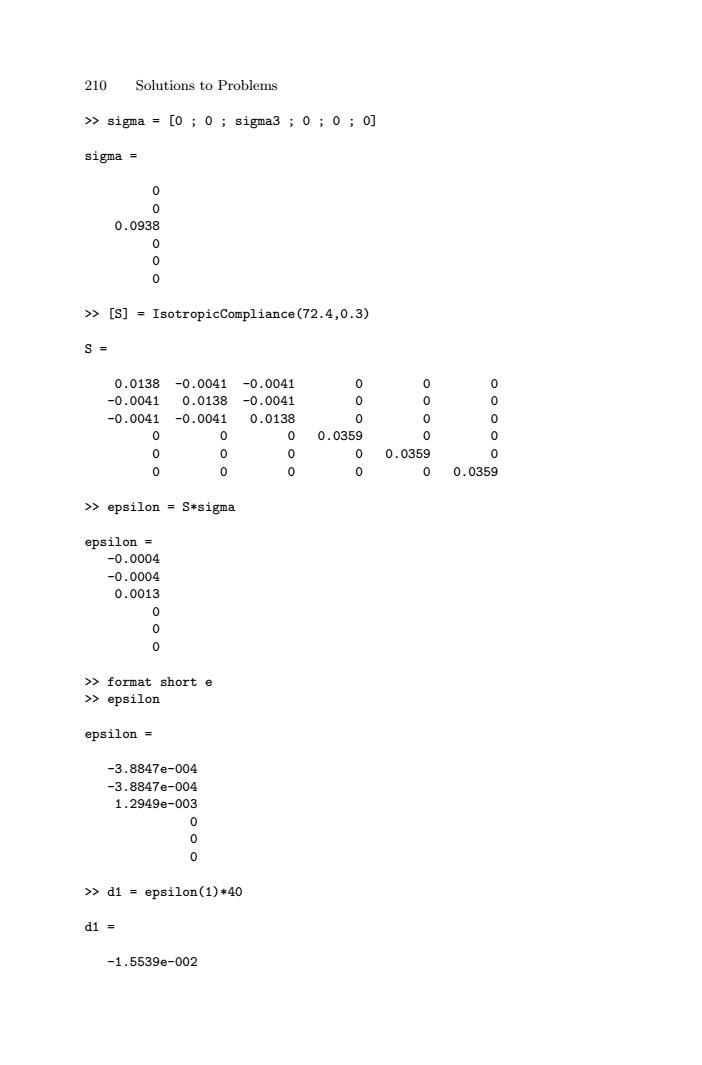
210 Solutions to Problems >sigma=[0;0;sigma3;0;0;0] sigma 0 0 0.0938 0 0 0 >[S]IsotropicCompliance(72.4,0.3) S= 0.0138 -0.0041 -0.0041 0 0 0 -0.0041 0.0138 -0.0041 0 0 0 -0.0041-0.0041 0.0138 0 0 0 0 0 0 0.0359 0 0 0 0 0 0 0.0359 0 0 0 0 0 0 0.0359 >epsilon S*sigma epsilon -0.0004 -0.0004 0.0013 0 0 0 >format short e >epsilon epsilon -3.8847e-004 -3.8847e-004 1.2949e-003 0 0 0 >>d1=epsi1on(1)*40 d1= -1.5539e-002
210 Solutions to Problems >> sigma = [0;0; sigma3 ; 0 ; 0 ; 0] sigma = 0 0 0.0938 0 0 0 >> [S] = IsotropicCompliance(72.4,0.3) S = 0.0138 -0.0041 -0.0041 0 0 0 -0.0041 0.0138 -0.0041 0 0 0 -0.0041 -0.0041 0.0138 0 0 0 0 0 0 0.0359 0 0 0 0 0 0 0.0359 0 0 0 0 0 0 0.0359 >> epsilon = S*sigma epsilon = -0.0004 -0.0004 0.0013 0 0 0 >> format short e >> epsilon epsilon = -3.8847e-004 -3.8847e-004 1.2949e-003 0 0 0 >> d1 = epsilon(1)*40 d1 = -1.5539e-002
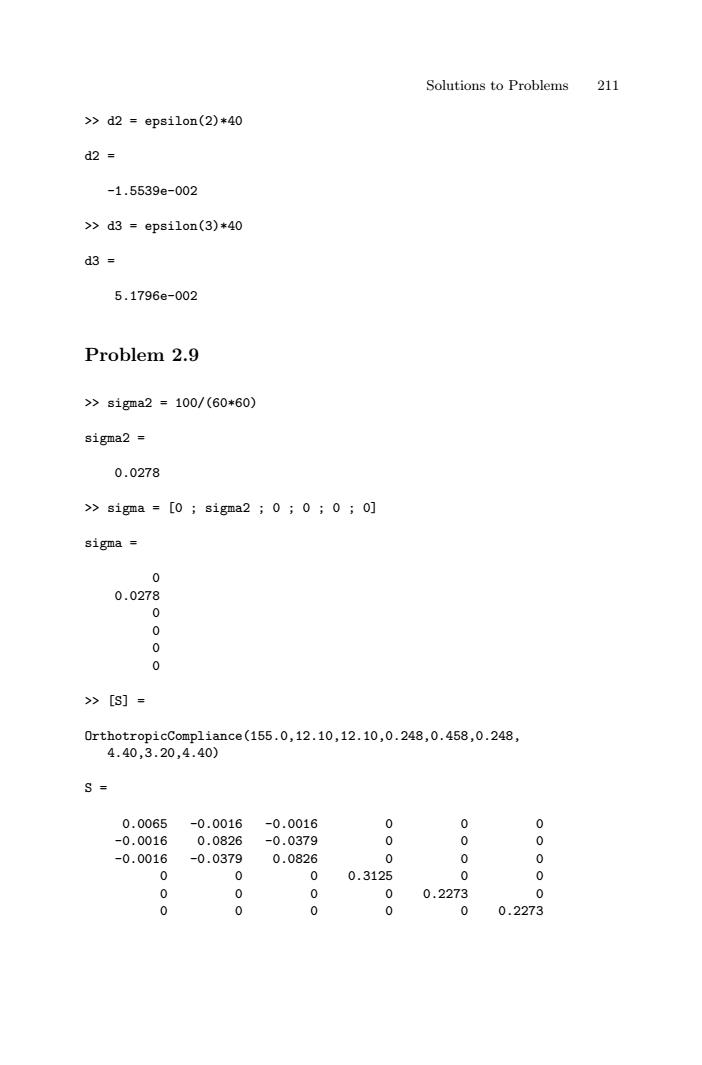
Solutions to Problems 211 >d2 epsilon(2)*40 d2= -1.5539e-002 >>d3=eps11on(3)*40 d3= 5.1796e-002 Problem 2.9 >s1gma2=100/(60*60) sigma2 0.0278 >s1ga=[0;s1gma2;0;0;0;0] sigma 0 0.0278 0 0 0 0 >[S]= 0 rthotropicComp1 iance(155.0,12.10,12.10,0.248,0.458,0.248, 4.40,3.20,4.40) S= 0.0065 -0.0016 -0.0016 0 0 0 -0.0016 0.0826 -0.0379 0 0 0 -0.0016 -0.0379 0.0826 0 0 0 0 0 0 0.3125 0 0 0 0 0 0 0.2273 0 0 0 0 0 0 0.2273
Solutions to Problems 211 >> d2 = epsilon(2)*40 d2 = -1.5539e-002 >> d3 = epsilon(3)*40 d3 = 5.1796e-002 Problem 2.9 >> sigma2 = 100/(60*60) sigma2 = 0.0278 >> sigma = [0 ; sigma2 ; 0 ; 0 ; 0 ; 0] sigma = 0 0.0278 0 0 0 0 >> [S] = OrthotropicCompliance(155.0,12.10,12.10,0.248,0.458,0.248, 4.40,3.20,4.40) S = 0.0065 -0.0016 -0.0016 0 0 0 -0.0016 0.0826 -0.0379 0 0 0 -0.0016 -0.0379 0.0826 0 0 0 0 0 0 0.3125 0 0 0 0 0 0 0.2273 0 0 0 0 0 0 0.2273
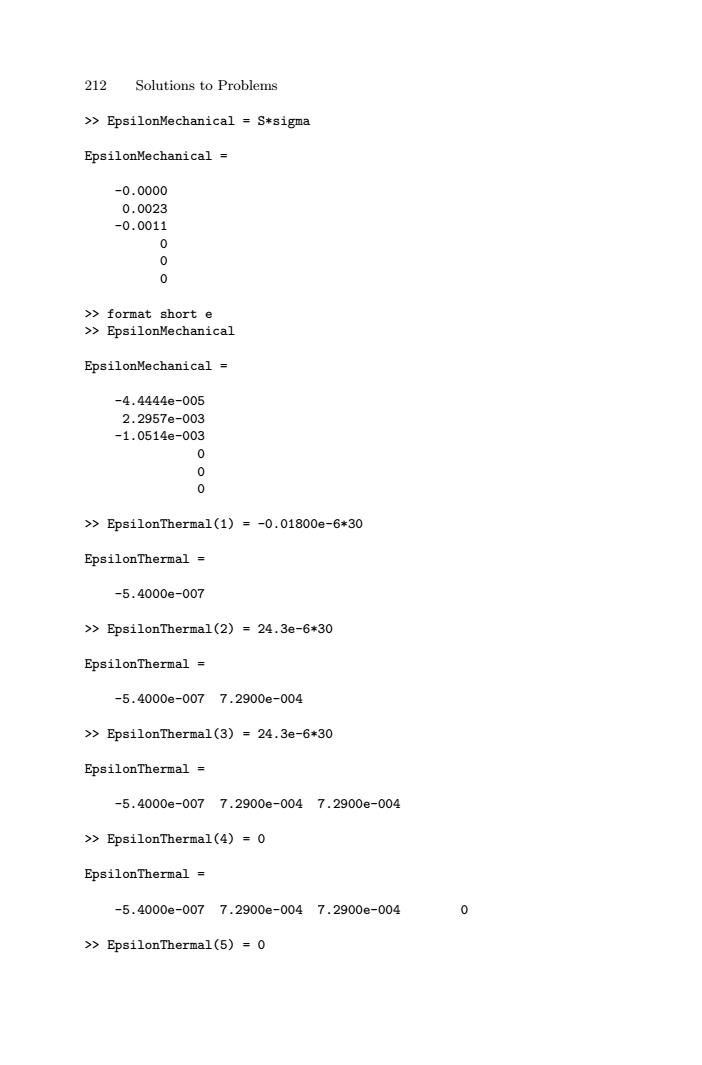
212 Solutions to Problems >EpsilonMechanical S+sigma EpsilonMechanical -0.0000 0.0023 -0.0011 0 0 0 >format short e >EpsilonMechanical EpsilonMechanical -4.4444e-005 2.2957e-003 -1.0514e-003 0 0 0 >>Epsi1 onTherma1(1)=-0.01800e-6*30 EpsilonThermal -5.4000e-007 >EpsilonThermal(2)=24.3e-6*30 EpsilonThermal -5.4000e-0077.2900e-004 >EpsilonThermal(3)=24.3e-6*30 EpsilonThermal -5.4000e-0077.2900e-0047.2900e-004 >EpsilonThermal(4)=0 EpsilonThermal -5.4000e-0077.2900e-0047.2900e-004 0 >EpsilonThermal(5)=0
212 Solutions to Problems >> EpsilonMechanical = S*sigma EpsilonMechanical = -0.0000 0.0023 -0.0011 0 0 0 >> format short e >> EpsilonMechanical EpsilonMechanical = -4.4444e-005 2.2957e-003 -1.0514e-003 0 0 0 >> EpsilonThermal(1) = -0.01800e-6*30 EpsilonThermal = -5.4000e-007 >> EpsilonThermal(2) = 24.3e-6*30 EpsilonThermal = -5.4000e-007 7.2900e-004 >> EpsilonThermal(3) = 24.3e-6*30 EpsilonThermal = -5.4000e-007 7.2900e-004 7.2900e-004 >> EpsilonThermal(4) = 0 EpsilonThermal = -5.4000e-007 7.2900e-004 7.2900e-004 0 >> EpsilonThermal(5) = 0
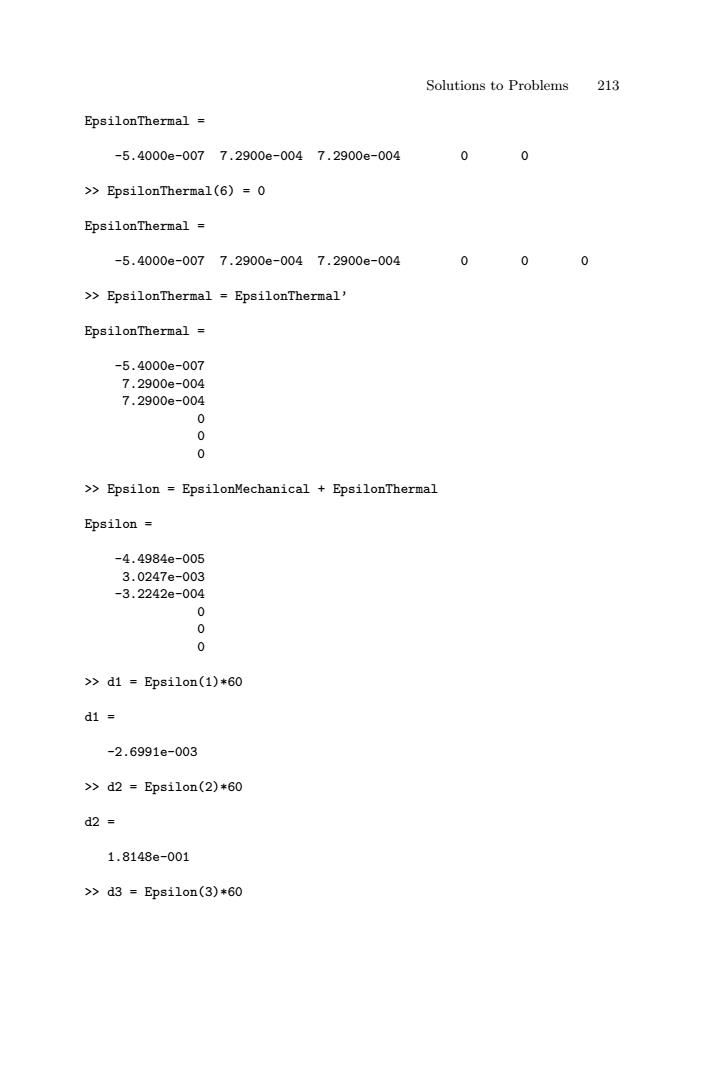
Solutions to Problems 213 EpsilonThermal -5.4000e-0077.2900e-0047.2900e-004 0 0 >EpsilonThermal(6)=0 EpsilonThermal -5.4000e-0077.2900e-0047.2900e-004 0 >EpsilonThermal EpsilonThermal' EpsilonThermal -5.4000e-007 7.2900e-004 7.2900e-004 0 0 0 >Epsilon EpsilonMechanical EpsilonThermal Epsilon -4.4984e-005 3.0247e-003 -3.2242e-004 0 0 0 >d1=Eps11on(1)*60 d1= -2.6991e-003 >>d2=Ep3i1on(2)*60 d2= 1.8148e-001 >>d3=Epsi1on(3)*60
Solutions to Problems 213 EpsilonThermal = -5.4000e-007 7.2900e-004 7.2900e-004 0 0 >> EpsilonThermal(6) = 0 EpsilonThermal = -5.4000e-007 7.2900e-004 7.2900e-004 0 0 0 >> EpsilonThermal = EpsilonThermal’ EpsilonThermal = -5.4000e-007 7.2900e-004 7.2900e-004 0 0 0 >> Epsilon = EpsilonMechanical + EpsilonThermal Epsilon = -4.4984e-005 3.0247e-003 -3.2242e-004 0 0 0 >> d1 = Epsilon(1)*60 d1 = -2.6991e-003 >> d2 = Epsilon(2)*60 d2 = 1.8148e-001 >> d3 = Epsilon(3)*60
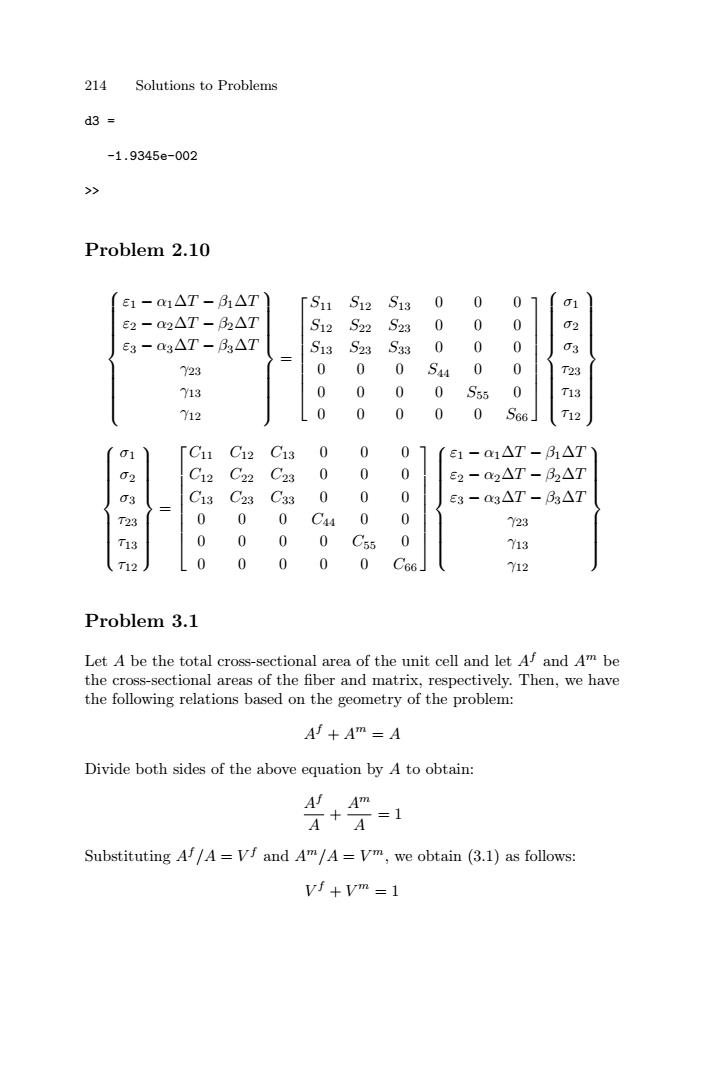
214 Solutions to Problems d3= -1.9345e-002 >> Problem 2.10 e1-a1△T-61△T S11 S12 S13 0 0 0 01 e2-a2△T-2△T S12 S22 52g 0 0 0 e3-ag△T-3△T 513 S23 S33 0 0 0 03 Y23 0 0 0 S44 0 0 T23 Y13 0 0 0 0 S55 0 T13 Y12 0 0 0 0 0 S66] T12 01 C11 C12 C13 0 0 0 E1-a1△T-61△T 02 C12 C22 C23 0 0 E2-a2△T-32△T 03 C13 C23 C33 0 0 0 E3-ag△T-3△T T23 0 0 0 CAA 0 0 23 T13 0 0 0 0 C65 0 Y13 T12 0 0 0 0 C66] Y12 Problem 3.1 Let A be the total cross-sectional area of the unit cell and let A and Am be the cross-sectional areas of the fiber and matrix,respectively.Then,we have the following relations based on the geometry of the problem: A+Amm=A Divide both sides of the above equation by A to obtain: A!Am A+A=1 Substituting A/A=V/and A"/A=Vm,we obtain(3.1)as follows: v5+vm=1
214 Solutions to Problems d3 = -1.9345e-002 >> Problem 2.10 ⎧ ⎪⎪⎪⎪⎪⎪⎪⎪⎨ ⎪⎪⎪⎪⎪⎪⎪⎪⎩ ε1 − α1∆T − β1∆T ε2 − α2∆T − β2∆T ε3 − α3∆T − β3∆T γ23 γ13 γ12 ⎫ ⎪⎪⎪⎪⎪⎪⎪⎪⎬ ⎪⎪⎪⎪⎪⎪⎪⎪⎭ = ⎡ ⎢ ⎢ ⎢ ⎢ ⎢ ⎢ ⎢ ⎣ S11 S12 S13 000 S12 S22 S23 000 S13 S23 S33 000 000 S44 0 0 0000 S55 0 00000 S66 ⎤ ⎥ ⎥ ⎥ ⎥ ⎥ ⎥ ⎥ ⎦ ⎧ ⎪⎪⎪⎪⎪⎪⎪⎪⎨ ⎪⎪⎪⎪⎪⎪⎪⎪⎩ σ1 σ2 σ3 τ23 τ13 τ12 ⎫ ⎪⎪⎪⎪⎪⎪⎪⎪⎬ ⎪⎪⎪⎪⎪⎪⎪⎪⎭ ⎧ ⎪⎪⎪⎪⎪⎪⎪⎨ ⎪⎪⎪⎪⎪⎪⎪⎩ σ1 σ2 σ3 τ23 τ13 τ12 ⎫ ⎪⎪⎪⎪⎪⎪⎪⎬ ⎪⎪⎪⎪⎪⎪⎪⎭ = ⎡ ⎢ ⎢ ⎢ ⎢ ⎢ ⎢ ⎢ ⎣ C11 C12 C13 000 C12 C22 C23 000 C13 C23 C33 000 000 C44 0 0 0000 C55 0 00000 C66 ⎤ ⎥ ⎥ ⎥ ⎥ ⎥ ⎥ ⎥ ⎦ ⎧ ⎪⎪⎪⎪⎪⎪⎪⎨ ⎪⎪⎪⎪⎪⎪⎪⎩ ε1 − α1∆T − β1∆T ε2 − α2∆T − β2∆T ε3 − α3∆T − β3∆T γ23 γ13 γ12 ⎫ ⎪⎪⎪⎪⎪⎪⎪⎬ ⎪⎪⎪⎪⎪⎪⎪⎭ Problem 3.1 Let A be the total cross-sectional area of the unit cell and let Af and Am be the cross-sectional areas of the fiber and matrix, respectively. Then, we have the following relations based on the geometry of the problem: Af + Am = A Divide both sides of the above equation by A to obtain: Af A + Am A = 1 Substituting Af /A = V f and Am/A = V m, we obtain (3.1) as follows: V f + V m = 1